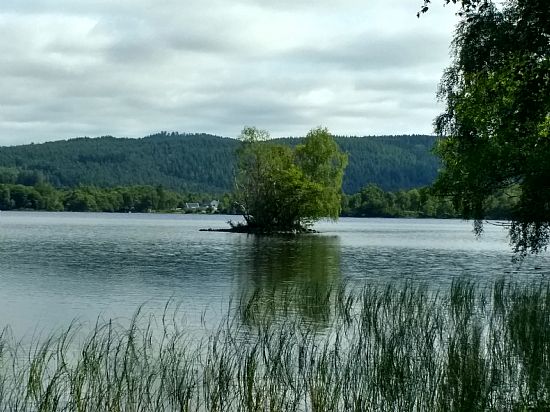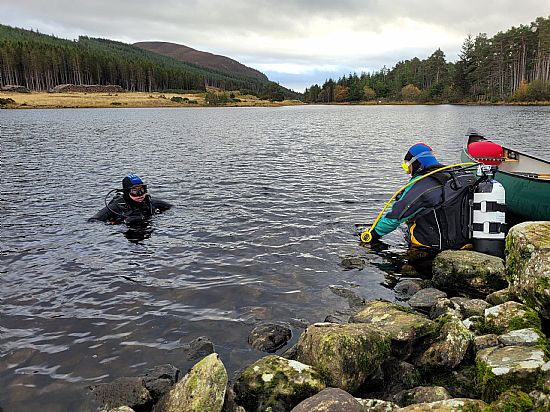Crannogs Project
Introduction
Anyone wanting to take part in this project , please contact the project lead: Richard Guest guestcharles1@gmail.com
 The project aim is to build up a database of the location of crannogs in the Highlands and to investigate a select few in greater detail. For the purpose of this exercise, we are defining crannogs as small islands in freshwater lochs which are entirely or partially man made. There is no maximum or minimum size but as a rule, think of a big hut circle surrounded by water. Changes in water level over time may make the crannog appear larger or smaller than its original size. They are typically circular or ovoid and consist of a pile of rocks of fairly uniform size, no bigger than a two-man lift. There has been very little investigation since antiquarian times and there is almost no hard dating evidence for any of them.
The project aim is to build up a database of the location of crannogs in the Highlands and to investigate a select few in greater detail. For the purpose of this exercise, we are defining crannogs as small islands in freshwater lochs which are entirely or partially man made. There is no maximum or minimum size but as a rule, think of a big hut circle surrounded by water. Changes in water level over time may make the crannog appear larger or smaller than its original size. They are typically circular or ovoid and consist of a pile of rocks of fairly uniform size, no bigger than a two-man lift. There has been very little investigation since antiquarian times and there is almost no hard dating evidence for any of them.
The project has reached a critical stage. The desktop study, in which we searched for potential unrecorded crannogs, is virtually complete. The site verification of targets identified in the desktop study is nearing a conclusion. The committee has now identified two sites for more intensive study.
Desktop Study
 An area of the mainland of the Highlands was studied, extending southwards from a line running roughly from Ullapool in the west to Golspie in the east, down to a line running through Loch Sunart, Loch Leven and the Blackwater reservoir. The western limit was the mainland coast, and the eastern limit was roughly the Highlands administrative boundary just east of Nairn and Aviemore. In all, an area of 1,860 sq km was studied by 26 volunteers, most but not all of whom were NOSAS members. Only a very small part of the desktop study remains to be completed. From satellite imagery the volunteers identified about 340 small islands which could potentially be crannogs. The steering group identified 57 of these for further study and from these, 35 were chosen to be visited.
An area of the mainland of the Highlands was studied, extending southwards from a line running roughly from Ullapool in the west to Golspie in the east, down to a line running through Loch Sunart, Loch Leven and the Blackwater reservoir. The western limit was the mainland coast, and the eastern limit was roughly the Highlands administrative boundary just east of Nairn and Aviemore. In all, an area of 1,860 sq km was studied by 26 volunteers, most but not all of whom were NOSAS members. Only a very small part of the desktop study remains to be completed. From satellite imagery the volunteers identified about 340 small islands which could potentially be crannogs. The steering group identified 57 of these for further study and from these, 35 were chosen to be visited.
Phase 3 of the desktop study is now under way. A volunteer is going through the Canmore and HER records, going back to the source data to establish just how much true archaeological data there is about them and how much is speculation or handed down from antiquarian times without scientific checking.
Site Investigation
Initially the sites were viewed from shore, and it was possible to eliminate most of them as natural islands, just by looking from shore. 8 sites required an underwater exploration, accomplished by scuba diving or snorkelling. 3 recorded crannogs were examined under water by divers, and one was visited by wild swimmers. Only a handful of the sites identified for further study remain to be visited. All the potential unrecorded sites examined so far, and one of the recorded crannogs, were judged to be natural islands.
 The desktop study has therefore failed to find a single unrecorded crannog and for this reason it is not proposed to expand the study area any further, although no work has been done in the northern highlands, or Moidart and Ardgour south of Loch Sunart.
The desktop study has therefore failed to find a single unrecorded crannog and for this reason it is not proposed to expand the study area any further, although no work has been done in the northern highlands, or Moidart and Ardgour south of Loch Sunart.
The Loch Glass recorded crannog was surveyed both above and below water and a plan produced.
The recorded crannog at Loch Achilty has been dived on three occasions. A tape and offset survey of the above water and underwater structure was completed and a plan drawn. Two timber samples were obtained which were submitted for carbon dating. These have yielded dates of c. 1060AD and 1359AD, suggesting it is of mediaeval construction.
Presentation of Results
As no new sites have been discovered, the steering group believe there is no need to write an investigation report of the desktop study for submission through Oasis. Instead, a report and a blog will be produced for the NOSAS website detailing the work carried out.
For Loch Achilty, a report has been submitted to Oasis and uploaded to the NOSAS website (see here), detailing the topographic survey, timber sampling and carbon dating. The report has now been uploaded to HER and will find its way onto Canmore in the fullness of time.
Future Proposals
 The project hoped to carry out an in-depth study of two recorded crannogs, Loch Kinellan and Loch Achilty. These are both possible mediaeval sites, only a few kilometers apart, and crannogs of this date are essentially unstudied in the Highlands. Only one mediaeval crannog has ever been extensively excavated, Keppoch’s Council Isle. The scope of a future project would be beyond the capability of NOSAS alone. It would require considerable funding – not only for site work but for post-ex, on a possibly large number of samples of waterlogged material.
The project hoped to carry out an in-depth study of two recorded crannogs, Loch Kinellan and Loch Achilty. These are both possible mediaeval sites, only a few kilometers apart, and crannogs of this date are essentially unstudied in the Highlands. Only one mediaeval crannog has ever been extensively excavated, Keppoch’s Council Isle. The scope of a future project would be beyond the capability of NOSAS alone. It would require considerable funding – not only for site work but for post-ex, on a possibly large number of samples of waterlogged material.
Loch Kinellan crannog was excavated in antiquarian times and the report in PSAS is one of the most thorough and scientific to be done in that era. The island consists almost entirely of organic material, with several well stratified layers of brushwood, timbers, clay and habitation layers with charcoal, hazelnuts and animal bone. Some mediaeval pottery was found. Re-opening one of the old trenches (which were well mapped at the time and are still evident on site) should make it possible to obtain dateable material through the whole sequence of occupation. However, digging the site would require scheduled monument consent and, after consultation with Historic Environment Scotland, it has been decided not to pursue this at the current time.
Loch Achilty, by contrast, consists mainly of stones, with the two sampled timbers the only visible ones which are considered to be part of the structure. There are many other timbers lying underwater, on top of the stones, which may or may not be contemporary with the structure. Professional advice is needed on an appropriate level of intervention. It is anticipated a partial dismantling of the underwater stone slope may reveal more timbers and provide an understanding of how it was constructed.
The Nautical Archaeological Society have expressed interest in running a project at the Loch Achility crannog. They have professional underwater archaeologists and a good track record in raising funding and completing technically demanding projects. It is hoped fieldwork here might take place in 2025.
A webmap compiled by the team which shows crannog sites can be viewed here.
